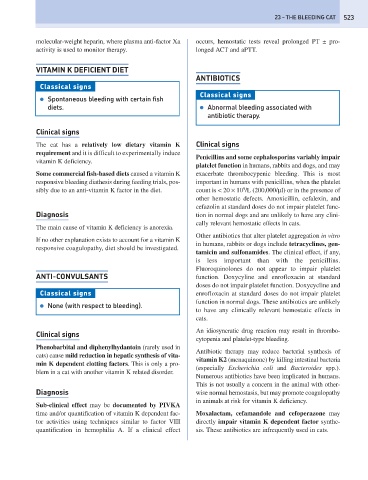Page 531 - Problem-Based Feline Medicine
P. 531
23 – THE BLEEDING CAT 523
molecular-weight heparin, where plasma anti-factor Xa occurs, hemostatic tests reveal prolonged PT ± pro-
activity is used to monitor therapy. longed ACT and aPTT.
VITAMIN K DEFICIENT DIET
ANTIBIOTICS
Classical signs
Classical signs
● Spontaneous bleeding with certain fish
diets. ● Abnormal bleeding associated with
antibiotic therapy.
Clinical signs
The cat has a relatively low dietary vitamin K Clinical signs
requirement and it is difficult to experimentally induce
Penicillins and some cephalosporins variably impair
vitamin K deficiency.
platelet function in humans, rabbits and dogs, and may
Some commercial fish-based diets caused a vitamin K exacerbate thrombocypenic bleeding. This is most
responsive bleeding diathesis during feeding trials, pos- important in humans with penicillins, when the platelet
9
sibly due to an anti-vitamin K factor in the diet. count is < 20 × 10 /L (200,000/μl) or in the presence of
other hemostatic defects. Amoxicillin, cefalexin, and
cefazolin at standard doses do not impair platelet func-
Diagnosis tion in normal dogs and are unlikely to have any clini-
cally relevant hemostatic effects in cats.
The main cause of vitamin K deficiency is anorexia.
Other antibiotics that alter platelet aggregation in vitro
If no other explanation exists to account for a vitamin K
in humans, rabbits or dogs include tetracyclines, gen-
responsive coagulopathy, diet should be investigated.
tamicin and sulfonamides. The clinical effect, if any,
is less important than with the penicillins.
Fluoroquinolones do not appear to impair platelet
ANTI-CONVULSANTS function. Doxycyline and enrofloxacin at standard
doses do not impair platelet function. Doxycycline and
Classical signs enrofloxacin at standard doses do not impair platelet
function in normal dogs. These antibiotics are unlikely
● None (with respect to bleeding).
to have any clinically relevant hemostatic effects in
cats.
An idiosyncratic drug reaction may result in thrombo-
Clinical signs
cytopenia and platelet-type bleeding.
Phenobarbital and diphenylhydantoin (rarely used in
Antibiotic therapy may reduce bacterial synthesis of
cats) cause mild reduction in hepatic synthesis of vita-
vitamin K2 (menaquinone) by killing intestinal bacteria
min K dependent clotting factors. This is only a pro-
(especially Escherichia coli and Bacteroides spp.).
blem in a cat with another vitamin K related disorder.
Numerous antibiotics have been implicated in humans.
This is not usually a concern in the animal with other-
Diagnosis wise normal hemostasis, but may promote coagulopathy
in animals at risk for vitamin K deficiency.
Sub-clinical effect may be documented by PIVKA
time and/or quantification of vitamin K dependent fac- Moxalactam, cefamandole and cefoperazone may
tor activities using techniques similar to factor VIII directly impair vitamin K dependent factor synthe-
quantification in hemophilia A. If a clinical effect sis. These antibiotics are infrequently used in cats.

